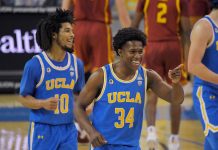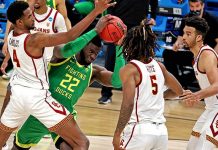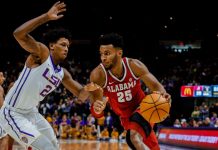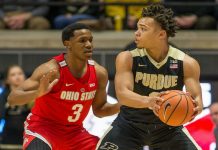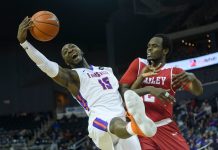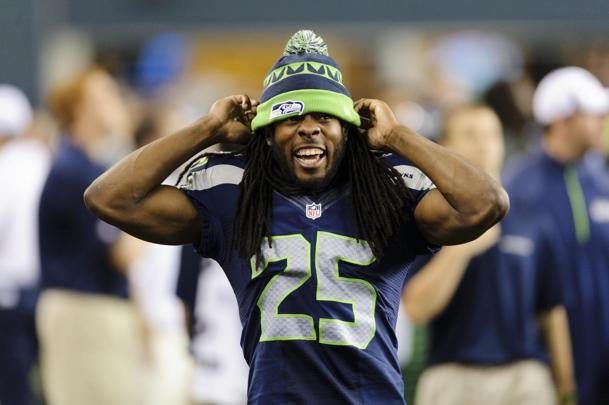PHOENIX (AP) Top-level basketball recruits played in gyms across Las Vegas over the summer, their final shot to impress college coaches during a live-recruiting period.
Around the same time in July, an undercover FBI agent was in a Sin City hotel room where more than $12,000 changed hands, money earmarked for influencing a high school player’s choice of colleges.
The meeting was one of several recorded by federal investigators during a three-year probe that led to the arrest of 10 people, including four assistant coaches at prominent schools. It also illuminated an aspect of college basketball the NCAA has failed to fully uncover for years: the shadowy world of recruiting.
”The NCAA’s never had the ability to enforce rules,” Utah coach Larry Krystkowiak said. ”I was told this summer by a coach, `If you’re not cheating, you’re cheating yourself.’ Certain conferences, I think, are notorious for doing that, and if you’re trying to compete in those conferences and you don’t do it, you’re going to be subpar. It’s a big egg on a lot of our faces.”
On Sept. 26, federal prosecutors announced the arrests of 10 people , including assistant coaches from Arizona, Southern California, Oklahoma State and Auburn. An Adidas marketing executive also was arrested, along with a tailor known for making suits for NBA stars in a case that alleges bribes were exchanged to influence high-level recruits’ choice of schools, agents and financial advisers.
The federal probe also implicated Louisville in paying a player to attend the school, leading coach Rick Pitino and athletic director Tom Jurich to be placed on administrative leave. Louisville has since started the process of firing Pitino for cause.
The arrests and accusations, though blockbuster in nature, were not exactly shocking to followers of the sport.
The shady side of recruiting has always been college basketball’s dirty little secret, standard operating procedure for numerous programs across the country about which little could be done.
The NCAA has had some success in uncovering the seamy underbelly of the sport.
In the 1990s, California coach Todd Bozeman was fired and the school was forced to vacate victories from two seasons after a pay-for-play scandal in which a recruit’s parents were given about $30,000. Kentucky was placed on probation for three years in 1989 after the NCAA found an assistant coach sent money to the father of a recruit to get his son to play in Lexington, among other violations.
Michigan was forced to forfeit 112 wins from five seasons, including a pair of Final Four appearances, after the NCAA found booster Ed Martin lent four players more than $600,000 as part of a gambling and laundering scheme. Coach Steve Fisher was fired in 1997 for violations involved in the scandal.
But for every NCAA takedown, countless others slip through the massive cracks in the system.
”When I did play, there was always rumors about guys getting this or that to be where they were, so this is nothing that is completely unexpected,” said Arizona State coach and former Duke standout Bobby Hurley. ”It doesn’t appear to be a system that works right now, so I’m sure there’s going to be a lot of conversation about that.”
The conversation may start with the shoe companies at the grass-roots level of basketball.
It used to be that high school coaches were the conduits to top recruits. Now the shoe companies run the show.
Adidas, Nike and Under Armour – a relatively new player in the hoops game – are on constant lookout for the next LeBron James or Steph Curry to make them millions.
The courtship starts early.
Today’s recruits often identify with a brand at a young age, in part because the shoe companies are so involved at the lower levels of the game, sponsoring tournaments and travel teams.
The shoe companies hope the early bond holds so the players – the ones who are good enough reach the NBA – will sign sponsorship deals with their brand.
Paying a player to attend a certain school or sign with a particular agent comes with a risk. Projecting the future of teenagers is an imprecise business, so there’s no guarantee the player will ever reach the NBA.
But the high end-game stakes push some shoe company representatives to risk small payouts for a chance to get in with a million-dollar star.
In the recent case, federal prosecutors allege three high school recruits were promised payments of up to $150,000 with money provided by Adidas and James Gatto, director of global sports marketing for basketball at Adidas, was among those arrested.
”The depth of the problem remains to be seen, but clearly there is indication of behavior that must be corrected for the health of basketball and the integrity of college athletics,” Southeastern Conference Commissioner Greg Sankey said.
It’s not a one-sided issue. Someone has to accept the money.
Many recruits come from low-income families and the promise of a lucrative payment can be enticing. A bidding war between schools is even better.
Assistant coaches or support staff can be easy targets for bribes. They don’t have nearly the salaries as head coaches, and the added income from a shoe company could be an appealing supplement.
The assistant coaches also have the added pressure of landing recruits. They are the ones who do all the legwork with the recruits and have the most contact with them, with the head coaches often coming in as the closer.
The federal arrests have illuminated this dark world as the NCAA never could have.
”I wasn’t sure in my lifetime that we were going to see anything of this magnitude where the lid got blown off,” Krystkowiak said. ”I was hopeful that at some point somebody’s going to pay the price.”
—
For more AP college basketball coverage: http://collegebasketball.ap.org and http://twitter.com/AP-Top25
25% Bonus via Western Union


